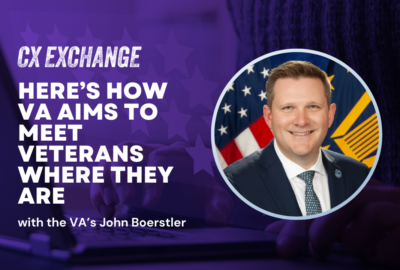The Department of Veterans Affairs is seeing signs that some of its newer special pay authorities are leading to improvements in workforce retention.
VA Secretary Denis McDonough told reporters on Thursday that “quit rates” for its workforce are at “historic lows,” and that data suggests its use of a new critical skills incentive (CSI) is contributing to higher retention.
The VA under the PACT Act — which expanded VA health care and benefits eligibility for veterans exposed to toxic substances during their military service — now has two pay incentives not seen elsewhere in the federal government.
The VA can now offer a critical skill incentive (CSI) to employees with skills that are in high demand, or in short supply at the department, and serve a “mission-related need.”
The department also implemented a Special Salary Rate for IT and cybersecurity employees, as well as human resources employees at the Veterans Health Administration.
McDonough said the VA has also been “more aggressive and more strategic” about using some of its other pay incentives, such as relocation and retention bonuses.
McDonough added that VA is seeing anecdotal evidence that nurses and other clinicians are seeking out jobs with VA over private-sector health care providers.
Travel nurse companies lured nurses with big hiring bonuses at the height of the COVID-19 pandemic. But more recently, McDonough said the VA is having more success recruiting nurses.
“We have some evidence to suggest that some of those nurses are returning, and they’re returning because of our nurse-to-patient ratios,” McDonough said. “I want to just hasten to say right now that we have not completely fixed our nurse staffing, although we’re up 10,000 over a year ago.”
McDonough said VA’s nurse-to-patient ratios are not “perfect in every facility,” but said nurses are generally spread thinner in private health care facilities.
“The stress that comes with an individual nurse covering multiple beds in an ICU, for example, in a community, is not matched to the VA system, where our patient ratios suggest that it’s a much different experience,” McDonough said. “So those are two things, I’d say. How we use the talent we have, and then how we’re paying for the talent that we have, mindful that, of course, always our biggest draw is the mission … We’re so on the upside on mission, we seek to draw even, or at least competitive on things like salary, and these new authorities have allowed us to do that.”
Michael Kelly, executive director of VA’s National Oncology Program, said the department is committed to supporting clinicians and taking steps to avoid workforce burnout.
“If we can’t deliver good care, because our people are burned out, That’s the problem,” Kelly said. “We are intentional about ensuring that when we are assigning duties and managing people, that we do so in a way which maximizes the experience for veterans, and that means not over-extending the staff. Over-extended staff are not going to be happy.
The House VA Committee recently advanced a bill that would require the department to make a permanent note of any investigation and its findings in the record of resigning employees.
The bill’s sponsor, Rep. Scott Franklin (R-Fl.) cited a recent investigation into sexual harassment at VA’s Office of Resolution Management, Diversity & Inclusion (ORMDI). VA substantiated many of the claims in its final report.
Franklin said in a statement when he introduced the bill last month that “VA staff must not be allowed to hide behind settlement agreements and other bureaucratic loopholes to avoid scrutiny and evade accountability for misconduct.”
McDonough said he had not seen the bill yet, but said that “on accountability and discipline generally, my view is that I really want to get us to a position where we’re managing this big, highly effective, but not flawless workforce.”
“A lot of the statutory changes in the last several years have actually had us before administrative bodies, before the MSPB, before even federal court, rather than managing our workforce. And we’re really serious about managing here,” he said. “We’ll obviously work with Congress as they consider new alternatives, but we really want to make sure that we are able to manage in a transparent, professional way, this workforce.”
VA is drawing down some of the extra staffing at the Capt. James A. Lovell Federal Health Care Center (Lovell FHCC) in North Chicago, after the rollout of its new Electronic Health Record there last month.
McDonough said VA increased staffing at the Lovell FHCC in preparation for the EHR go-live, and that that augmentation in staffing has begun to draw down in the last few weeks.
The Lovell Federal Health Care Center is DoD’s final go-live site for the new Oracle-Cerner EHR, which it calls MHS Genesis.
Kelly said DoD has fully implemented the Oracle-Cerner EHR in its oncology operations at Lovell FHCC.
“They are pretty much up to speed on providing that care in a way, which is approaching the efficiency that they expect it to be able to get to,” Kelly said.
While VA employees have given the Oracle-Cerner EHR low usability scores, as documented in watchdog reports, Kelly said adapting to the system is a matter of “learning the keystrokes.”
“I can do CPRS with my eyes closed, because I’ve been doing it for decades,” he said, referring to VA’s legacy EHR system. ” But I can’t do Cerner with my eyes closed. I have to have them wide open, and I have to look at every icon on their screen, because they have a lot of icons on their screens. But the people who are used to it, they breeze right through it. So it’s going to take some time for us to learn that, the muscle memory to be able to use the system efficiently.”
Copyright
© 2024 Federal News Network. All rights reserved. This website is not intended for users located within the European Economic Area.





